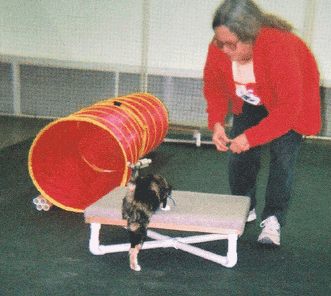Are You and Your Cat Ready for Agility?
- Self Confidence: Can your cat handle new situations calmly, and enjoy investigating new things? Are new people interesting to your cat? Your agility cat should be interested in agility, love running, jumping and climbing, and generally be interactive with the people, cats and objects in its environment. Shy cats may enjoy playing at home, but may be limited in their ability to have fun and enjoy agility at shows.
- Motivation: One of the primary motivators for dogs is food, but for cats, it is play. Isn't that wonderful? Play with your cats, run them around the house, and if they do something well, reward them with praise, or a very small tidbit of food., but mostly praise and love. Cats running and agility course also need to be focused, paying attention to their handler, alert and responsive. Praise and love at home will keep up the focus level in the agility ring. Clicker-training to follow a target stick is very effective.
- Athletic Ability: In order to negotiate the obstacles on an agility course, a cat needs good overall health, stamina, conditioned lean weight, and an energetic outlook on life. Have your cat checked by a veterinarian and make sure it is physically up to agility, free from any malady or structure flaw that will interfere with its ability to run or negotiate obstacles. You and your cat can have fun if you're both healthy and interested in agility, even if reaching superstardom isn't reachable because of your cat's basic conformation.
- Training: Once you've determined your cat has the right temperament and physical condition for agility, ICAT recommends the applied operant conditioning method of training ("clicker training") your cat and getting it accustomed to the handling obstacles, where mistakes are ignored and the cat gets rewards, usually praise, for what it does correctly. Some research suggests that handling kittens each day during the first month of their lives improves learning ability, so start loving them early! Be patient, and find the joy in working together and build a relationship with your cat. You can lure the cat through the obstacles with a toy, if desired, which may turn out to be just as fast as voice direction. No matter how they get around the course, the cats having the most fun are probably going to be the ones who do the best.
- "Cat Years": ICAT agility competitions are for cats 8 months of age or older, when they have reached the equivalent of their young teenage years. Kittens 4 to 8 months old may practice on the basic level course, but not compete. Cats will age 10 years in the first six months of their life. In the next six months, they will age five more, bringing the total number of "cat years" to 15 in their first year of life. After this initial age spurt, you can expect your cat to age four years for every year of its life. So if your cat is three years old in "people years," it is 23 years old in "cat years."
Start Young!
How young should you start cat agility? Taty Kalani started Stardust at five weeks as you can see in this video (2.3Mb) - play with your cat every day!
For amusing stories about adventures with cats, see Lisa-Maria Padilla's MeowClick.
Calico household pet kitten being clicker trained at a show where she was up for adoption from a shelter. (She was adopted!) |
<script>
(function(i,s,o,g,r,a,m){i['GoogleAnalyticsObject']=r;i[r]=i[r]||function(){
(i[r].q=i[r].q||[]).push(arguments)},i[r].l=1*new Date();a=s.createElement(o),
m=s.getElementsByTagName(o)[0];a.async=1;a.src=g;m.parentNode.insertBefore(a,m)
})(window,document,'script','https://www.google-analytics.com/analytics.js','ga');
ga('create', 'UA-85676953-1', 'auto');
ga('send', 'pageview');
</script>


